Abstract
This research work is aimed at identifying the applicability of additive manufacturing (AM) to spare parts in the automotive manufacturing industry, specifically in the field of preventive maintenance. A procedure of AM applicability to preventive maintenance is presented. To this end, the results of the application of a case that has been carried out in the Stellantis factory located in the Vigo (Spain) area have been obtained. The procedure was based on an initial inventory from which a series of lists have been obtained that were later categorised. This was performed in order to know the technical and economic applicability of polymeric spare parts replacement by parts made of AM in polyamide material (PA12) through two manufacturing methods (HP Multi-Jet and Selective Laser Sintering technology, SLS). Original spare parts were characterised and compared with replacement parts made in AM. This article provides observations, recommendations and conclusions to summarise the situation regarding the use of AM techniques to improve preventive maintenance.
1. Introduction
Nowadays, AM applications can be found in many domains, for example, architecture and construction fields where 3D building models are printed on a reduced scale to have a future view of the real building before its construction and to study its characteristics before its creation [1]. In other fields such as the medical field [2,3], real improvements have been made in prostheses that are used in almost every part of the human body, dental prostheses, transfemoral prostheses for the elbow and knee, etc. [4].
With 3D printing, engineers can develop and print very complex designs that allow them to make a wide variety of designs that can be modified at any time in CAD files. These modifications can be made when a variable needs to be changed, which makes the technology very flexible. This AM process works by melting the material and joining it to create layers which will form a volume or the 3D object. There is a wide variety of materials and manufacturing processes used in 3D printing. The material and technology used are connected depending on their type. The different AM concepts and methodologies used are standardised according to ASTM and ISO standards [5,6].
This work aims to find out whether AM can play an important role in industrial maintenance, specifically in preventive maintenance. One of the main fields concerns the possible replacement of spare parts in the maintenance inventories of manufacturing companies, where the stock is very active for some parts but remains static for other parts. The real challenge is to know whether there are spare 3D printable parts in the inventory, to try to replace them with digital files. These digital files could be used to print the necessary parts on demand for preventive maintenance at any time without disturbing the production line and ensuring that they work like regular spare parts.
Khahavi et al. studied the modelling of scenarios of a spare parts supply chain in the aircraft industry. The spare parts supply chain of the F-18 Super Hornet fighter aircraft was selected as a case study because the air-cooling ducts of the environmental control system are manufactured using AM [7]. Researchers Sirichakwal and Conner examined how AM affects spare parts inventory management. The methodology was applied to a real-life study to highlight the impact of AM implementation on inventory strategies [8]. The use of AM technology allows for the on-demand printing of spare parts through 3D printing centres, eliminating the need for companies to maintain an inventory of spare parts. The cost of some spare parts in the additive manufacturing process is generally lower than in conventional manufacturing, the latter wasting a lot of material. AM makes it possible to produce very complex parts very quickly while saving material. It can be a very good potential tool for maintenance, especially when it comes to polymers.
The reliability of spare parts has been studied by Kostidi et al. in relation to parts manufactured by conventional methods. They have carried out material characterisation tests which have been compared with the original spare parts. They have also studied the comparative cost of both parts [9]. According to Westerwell et al. [10] maintenance organisations should incorporate on-demand printing of spare parts into their maintenance processes with great cost savings.
The fourth industrial revolution, also called Industry 4.0, integrates a set of emerging and converging technologies that add value to the whole product life cycle [11]. In this new industrial stage, all work activities in the value chain will be performed with intelligent approaches (Smart Working) based on information and communication technologies (ICTs). Industry 4.0 marks the beginning of a new industrial era in which different technologies are used to increase quality, productivity and efficiency in production systems. Industry 4.0 is bringing about a change in the design and operation of supply chains [12,13]. In this context, the characteristics of additive manufacturing improve manufacturing systems, enabling them to produce more complex parts in a shorter time and in a more cost-efficient way. There are studies that claim that the use of additive manufacturing for spare parts has a potential that has not yet been fully explored. AM enables the production of old spare parts, facilitates the management of stock levels of those products with a high level of customisation, and decentralises production. Integration of AM in the design of supply chains can be considered a strategic decision that is part of the fourth industrial revolution [14].
The concept of digital spare parts has not yet gained much ground in the manufacturing industry. Researchers Kretzschmar et al. identified some reasons for its selective rejection. This study has been conducted from a corporate perspective, outlining a holistic structure of the supply chain network, to visualise different digital spare parts distribution scenarios, and assessing the technical and economic capabilities of additive manufacturing [15]. Additionally, other threats regarding the use of digital spare parts have to be explored, such as the cyber security issues inherent to the Industry 4.0 paradigm during the transfer, execution and storage of the digital models [16]. Despite its interest, particularly in developing specific cyber security infrastructures and solutions for the AM scenario, this topic is out of the scope of this paper.
Zhang et al. have analysed, through discrete event simulation, the use of AM as a replacement for traditional warehouse inventory for an on-demand spare parts supply system. A generic AM system based on a powder bed fusion was used in the model, and the same modelling approach could be applied to other types of AM processes. Using this model, this paper studied the impact of the characteristics of spare parts demand (e.g., part size attributes, demand rates) and the way the AM operation characteristics (e.g., machine size and deferral strategy) affect the performance of using AM to supply spare parts [17].
Montero et al. analysed the manufacturing of the spare part at the place where the equipment needs it, which provides an interesting opportunity to implement additive manufacturing techniques in the field. They have conducted a case study of a spare part, particularly a valve cover used in electric diesel generators, needed by the German Federal Armed Forces, with a methodology for handling the data in the integrated design and manufacturing process [18].
Lopez de la Calle et al. have compared the reliability and cost of a jet engine with components manufactured using additive manufacturing or welded parts. In the process, key reliability characteristics of AM are found, and overhaul schedules are defined for a fleet of aircraft manufactured with AM aircraft components. The simplicity and performance demonstrated in the comparison make the proposed method a powerful engineering tool for the evaluation of additive manufacturing in aeronautics [19].
Beiderbeck et al. have identified potential benefits in the automotive aftermarket for transforming this business by providing individualised spare parts on demand and on-site, without the need for costly tooling. However, their results also revealed that neither of the two concepts is technically feasible from today’s point of view. Nevertheless, additive technologies have advantages, as outlined in this study, which will affect the automotive aftermarket in the future [20].
Yang et al. have proposed a decision support system (DSS) to automatically determine the suitability of a spare part or assembly for AM applications, based on machine learning (ML) and carefully selected choice criteria. In order to support efficient candidate selection in the early conceptual design phase, these criteria are individually decoded into decisive parameters that can be extracted from digital models or resource planning databases. More than 200 existing industrial examples are manually collected and labelled as training data; in the meantime, multiple regression algorithms are tested against each potential AM to find better predictive performance [21].
In the study of AM implementation methodologies for spare parts, categorisation with respect to economic and technological criteria is important. In this field, Gughe et al. used the Delphi method to determine and validate the relevant criteria for the classification of spare parts. This generic framework benefits professionals in identifying technically compatible spare parts for AM that enhance the company’s competitiveness [22].
Chekurov et al. identify distrust in quality, insufficient knowledge of materials and design among stakeholders, as well as poor availability of spare part design documentation as the main barriers when adopting AM in spare part production. These three key barriers are interconnected. They conclude that training engineers in design and material issues, as well as in the development of high-quality design documentation, will significantly increase the implementation of AM in aftermarket parts [23].
Spare parts redesign has been studied by Montero et al., providing design considerations based on agile hardware development practices to improve the quality of spare parts and reduce delivery times. This methodology is derived from case studies in the military over two years. The study presents three different use cases that follow this methodology, and provides process weaknesses and recommendations for production engineers and designers [24].
The study of a structured approach to the configuration of the spare parts supply chain should determine whether to centralise or decentralise stock management, also considering hybrid configurations. Furthermore, such a method should define whether there is a need to switch the production of spare parts from conventional manufacturing (CM) to AM technologies [25]. Up to now, little consideration has been given to the impact of AM on spare parts inventory management, both from a technical and an economic point of view. For this reason, several studies have contributed to clarifying when the use of AM for spare parts inventory management would provide benefits over CM techniques from a technological point of view [26,27,28].
The main objective of this work is to determine the possible spare parts of an automotive manufacturing company in order to print them and study their usability, getting to know if they are susceptible to be used as regular parts and if they are affordable in preventive maintenance with the goal of improving the maintenance domain with 3D printing. The novelty of this research work lies in the use of spare parts made by additive manufacturing in an industrial automotive factory. This means that it is applied, not to the product, but to the manufacturing process itself. It can also be noted that a methodology for the selection of process spare parts is developed.
2. Methodology
The experimental methodology of this work consists of the next points:
- Proposed process for Preventive Maintenance (PM) using AM;
- Availability of materials and processes;
- Case study, including the following steps:
- -
- Categorisation of the spare parts of the inventory by classifying them into multiple categories using certain criteria in order to know what pieces are suitable to be made by additive manufacturing [29];
- -
- Selection of some pieces from the automotive manufacturing company’s inventory by making a study about their use and their estimated AM prices, taking into account the additive manufacturing companies located in the same area [28,30,31];
- -
- Selection of the materials and processes to print the parts and perform several tests on the originals and the printed one, for a comparative analysis of the obtained results;
- -
- Setup of the different preventive maintenance methods found.
2.1. Proposed Process for Preventive Maintenance Using AM
In a manufacturing company, when the production process stops, it is because of a problem; when it occurs, the nature of the problem must be defined immediately [1]. If the problem is external to the spare parts, a solution is required to continue the production. If the problem is related to a spare part, the process begins by checking the inventory for the needed spare part. If it is present in the inventory, the technicians or the engineers take it directly from the inventory and replace it. However, if the spare part is not available, they print it using an adequate 3D printer for its posterior use. Figure 1 is a flowchart showing how the decision to print a spare part using AM technologies is made. In preventive maintenance, as an improvement on corrective maintenance, technicians must detect the problem as early as possible in order to prevent the problem. Then they could analyse if the spare part could be printed and know the print time (PT) and the replacing time (RT) and incorporate them in the manufacturing chain before the production stops, as shown in Figure 1. Ideally, the parts should be printed at the company in a minimum amount of time to save costs, or have a local supplier of AM spare parts.
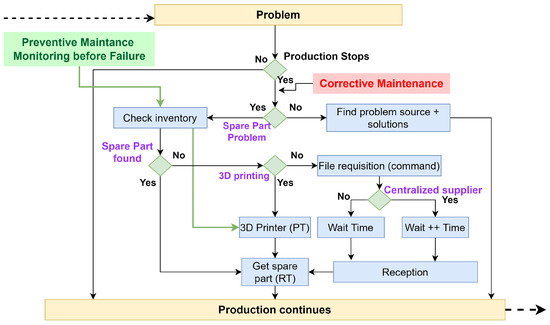
Figure 1.
Flowchart decision for AM spare parts in Preventive Maintenance.
Figure 2 shows the systematic replacement of printed spare parts respecting a calendar or time intervals. For example, every week, it depends on the mean of the printed part working time (MPPWT) where its formula is expressed in Equation (1).
- MPPWT: Mean printed part working time;
- PPWTi: Print part i working time;
- A1…An: Schedule time to change the printed spare part.
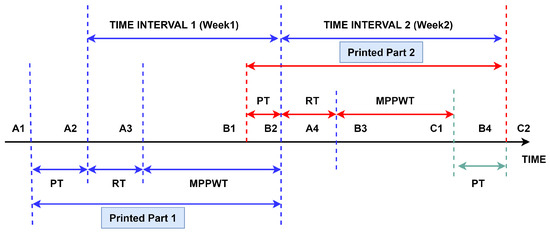
Figure 2.
Proposed systematic PM schedule using AM technologies.
The scheduled time to change the printed spare part is the sum of the printing time (PT), the replacing time (RT) and the mean printed part working time (MPPWT). As can be seen in Figure 2, this time goes from the A2 point to the start A4 point. The printed part 1 life starts from end A1 when its manufacturing begins; it takes a certain time for the part to be printed and ready to use, then it is taken into the equipment to replace the old part, which takes a replacing time and, finally, the object can start functioning in the equipment. The working lifetime of the printed part 2 is larger than the working life of the printed part 1 due to the initial decision to print not being taken into account and this PT is always used in scheduled intervals of time.
The MPPWT is the working time of the printed part or the time that it is operational on the equipment. As a condition, the 3D printer must be within the company that will use this type of preventive maintenance. One of the advantages of this type of preventive maintenance is the on-demand printing of parts, which results in good working conditions for the stock, as spare parts are released due to just-in-time on-demand printing [32]. If there is a need to replace old equipment that uses regular spare parts already in the company’s stock, it will cause a loss of money that can be avoided by printing the parts just in time when the moment for replacement is near. However, many companies prefer to purchase their spare parts instead of manufacturing them because of money issues. Even for this problem, the solution may lie in providing printed parts from 3D printing manufacturers.
2.2. Availability of Materials and Processes
The materials that can be applied in AM can vary depending on the technology used and the functional needs of the spare parts that have been selected. As shown in Figure 3, the AM process is based on two levels. The first level is the digital level which consists of obtaining a CAD file. This format must be translated into a format understandable by the slicer. The stereolithography (.stl) and 3MF (.3mf) formats are widely used as input to the slicer processor. The output of the slicer processor is the G-Code, which is sent by the machine controller to the selected technology. The second level is the physical level where the digital model is manufactured.
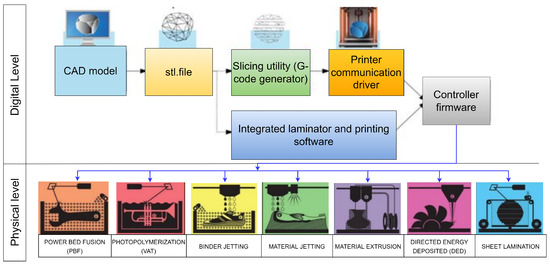
Figure 3.
The additive manufacturing process (AM) according to ISO/ASTM 52900.
In the AM process, the piece can be manufactured in different positions,; most of the time the orientation is taken into consideration, particularly in extrusion material technology to avoid stresses in the built part. In powder bed fusion technology (PBF), this problem is avoided because the powder already does the job of the supports, counter to conventional machining where generally the orientation is limited and depends on the tool which removes the material and on the working trajectory because of its special geometry. The AM process can build any part with very complex geometry, so additive manufacturing is considered a fast-forming technology compared to conventional machining. The disadvantages compared to conventional manufacturing can be cost, functionality and accuracy. The AM has multiple varieties of materials which can be found in filaments (FDM), powders (SLS) and liquids (SLA). AM allows manufacturing with a wide variety of materials, the four known families are polymers, metals, ceramics and woods, but in this study, we did not consider woods and ceramics because they are not used in the industrial field. Metal was not considered either, as we selected parts that did not need to be manufactured in metal.
There are many AM processes, and they are different from each other, their diversity being due to their characteristics and the raw material used. Figure 4 helps with choosing the right 3D printing material by first searching the adequate 3D printing technology and then looking for the materials available to print with. The figure also shows the process used for the 3D printing technology and there are six known processes: powder bed fusion, metal extrusion, vat polymerisation, material jetting, binder jetting and direct energy deposition [5,6]. In this case study, one material and two different processes for the same material were chosen:
- PA12 (Polyamide 12) in form of powder. The spare parts were processed by HP Multi-Jet technology;
- PA12 (Polyamide 12). The spare parts were processed by powder bed fusion, by an SLS machine [33,34].

Figure 4.
AM technologies sorted by the material family according to ISO/ASTM 52900.
3. Results: Case Study
The real application case of this work is focused on the automotive industry, more specifically, the Stellantis® factory located in Vigo (Spain), which has a spare parts inventory of around 50,000 pieces. The first step is to study and categorise this spare parts inventory. All the stored parts are classified in a data file that contains their administrative and technical information but lacks AM applicability information. The method used to classify the spare parts consists of selecting a list of parts using different criteria to study their possible applicability to AM. In order to do this, it has been necessary to consult the technical specifications of each spare part and relate them to the available parameters of the AM technology.
This study was developed to identify which spare parts are printable for use as operational parts. The first step was to establish a categorisation of these spare parts, focusing on their printability. Therefore, the possible use of these AM-printed spare parts was then analysed for use in preventive maintenance, with the aim of reducing the stock of spare parts in the inventory. A package of parts was chosen to be AM-printed with different technologies and different materials depending on the usual spare parts and their functionalities and properties. They were then tested to see if they can replace the original ones or help to make an improvement in any other way. The main objective of this work was to make a selection in order to determine the possible spare parts of a car manufacturing company, print them and study their usability, while checking if they can be used in preventive maintenance.
3.1. Working Database
The working database used in this work contained essentially two tables which are related by the unique part code index:
- Stock table: it is a table containing all the references of the spare parts present in the inventory such as their name, references, location in the stock, the unit price of the spare part, their current quantity in the stock, annual consumption, etc. The table contains a lot of information, and the most important information items are reference code, designation, location, imposed stock, total stock, unit price, stock value, purchase family, annual consumption, and reparability. It also contains administrative information, such as the responsible persons of the departments that are directly related to the supply of spare parts;
- Spare parts usage table: the spare parts management database contains documentation on the uses of the spare parts in stock. It includes corrective and preventive maintenance information and it contains information on replacement times, usage times and failure times for each part. Once the search is performed and the product is found, the table shows a pdf or an image with the available technical information related to the product, such as dimensions, material, etc. This table is connected to other databases from other sectors belonging to the same company, with the aim to search and provide the necessary information, given that they use the same references and codes for spare parts, which facilitates the exchange and management of documents between different departments of the factory.
3.2. Selected Lists
Due to the high number of parts in the database, and in order to address the problem of applying AM to spare parts, it is necessary to first select the parts that allow us to parameterize the problem (Figure 5). For this purpose, the following six lists were defined and selected:
- The first list (1): this family of parts is chosen because all the parts present in this family are owned by the car manufacturing company, so the copyright issue will be avoided, as the study requires the reproduction of some spare parts with 3D printing technology. The method of selection of parts from this list was as follows:
- -
- Unit price equal to or higher than 80 €. Knowing that the 3D printing manufacturing process is more expensive than conventional manufacturing processes, a price limit was set to select all parts that are equal or cost more than 80 €;
- -
- High consumption. The company showed a high interest in parts with high consumption, especially in the expensive spare parts for cost-saving purposes.
The 95% of the parts selected in the first list was made up of mechanical construction spare parts, such as gears, cylinders, shafts, pilots, transmission wheels, welding electrodes, etc. Many of them are metallic, which are difficult and expensive to print using AM technologies. All the mentioned parts were manufactured with high precision and require a very smooth surface due to their functionality, which consists of being used in tight assemblies. The tolerance levels of these assemblies are highly respected, there is no margin for error when it comes to mechanical construction assemblies, as they have a high and critical impact on production machines. These spare parts are heavy, which means they require a considerable amount of material that can be expensive for AM metal parts and that can take a long time to manufacture depending on the 3D printing process used. This situation can contribute negatively to the maintenance time by delaying the repair time. Other assemblies have been found, such as wheels, which are made by assembling two types of materials, metal and polymer, for example, steel and polyurethane. Some of them are a mixture of other assemblies that are, at the current time, impossible to 3D print, such as the hydraulic cylinder, which is an assembly containing more than five parts. Another example, such as air conditioning tubes containing metal fibres immersed in polymer, cannot be printed, as it is still very difficult to print two different types of materials at the same time, especially when it comes to metal and polymer. The 5%, which is the remainder of the first list, represents consumables, such as tools that are hardly used. These parts are not good candidates for 3D printing because they are more expensive to print than regular parts; - The second list (2): it is a list of parts that do not contain any technical information in the database (no drawings). Their 3D printability was studied by directly and physically checking them in the inventory to know if they are good candidates for 3D printing. Most of the parts in this list have some characteristics like the ones in the first list. This list contains many mechanical construction parts such as shafts, gears, etc.;
- Third list (3): the printability of the parts in this list was studied and some of them were selected as good candidates for 3D printing. They are different from the previous lists and a few of them present some similarities with the previous ones. This last selected list contains parts that have these characteristics:
- -
- High Hardness: the parts that were found in the list are very hard and were post-processed by being heat-treated to be used in difficult situations, for example, parts such as electrode sharpeners which are made of very hard material used for sharpening welding electrodes. Another example could be a tool head that is used to transfer loads or to transmit rotations;
- -
- Small and medium size: most of the time they are small and hard parts and sometimes medium-sized parts that do not reach more than a cube volume of mm;
- Fourth list (4): this category includes large-volume individual parts made of metallic material. All parts selected in this category are similar to the ones in category 2, but have a larger volume. Most of these parts are of mechanical construction with large diameters (more than 500 mm) and shaft lengths of more than 800 mm;
- Fifth list (5): this category groups assembled parts containing two or more pieces. They are parts made of multiple materials (polymers and metals) and have a small or medium volume, not exceeding mm. They are parts manufactured by combining a metal and a flexible polymer such as elastomer that will protect the metal by absorbing impacts or other loads;
- Sixth List (6): this list includes assemblies made from a single family of materials. Category 6A group assemblies are made of polymers only and category 6B group assemblies are made of metals. When roughness is not a constraint, some assemblies can be printed by SLS technique;
- External list: it is a list of pieces selected by technical criteria which are in a relationship with 3D printing parameters and characteristics, and that are available and suitable for the technology; the criteria were as follows:
- -
- Metallic materials: for example, stainless steel, aluminum and titanium, available in 3D printing technology;
- -
- Polymeric materials: for example, thermoplastic and thermosets like Epoxy, ABS (Acrylonitrile Butadiene Styrene) and PA (Polyamide);
- -
- Pieces that do not exceed a volume dimension of mm to ensure their entire volume printability in the 3D printer without dividing them into parts and joining them together to conserve the same properties and the geometry of the original part.

Figure 5.
Examples of classified spare parts: (a) from list 1A (polymer), (b) from list 2B (metal), (c) from list 3A (polymer), (d) from list 4 (large part), (e) from list 5 and (f) from list 6.
3.2.1. Categorisation Criteria
Based on the parts mentioned above and selected from the stock of the car manufacturing company, a categorisation was made following multiple criteria and priorities, for these parts to be printed and to check their usefulness for preventive maintenance. The methodology followed to categorise the spare parts was based on the following criteria:
- Structure of the part or assembly: it is important to know if we are dealing with an assembled piece or a unique one, in order to determine if the 3D printed assembled part is operational or not. There are many types of assemblies where the parts cannot be printed quickly due to the variety of materials, the process to be used or the parts that cannot be printed. The distinction was made between the individual part and the assembled part;
- Size and volume of the spare parts (Vsp): given that the selected pieces were taken from an automotive manufacturing enterprise, the dimensions mm were taken as a reference limit for the medium and high volumes, because the printing area of the 3D printers for industrial use exceeded the reference volume. The following groups were distinguished:
- -
- Large: Vsp > mm;
- -
- Medium: mm < Vsp < mm;
- -
- Small: Vsp < mm.
- Material: Material: this criterion considers whether it is a single material or a multi-material. It also takes into account whether it is metal, ceramic or polymeric. It is necessary to know whether it is possible to print with the material used in the usual part or, if not, to identify the replacement material, for example, by checking its mechanical properties;
- Rigidity (class): this criterion is used qualitatively and differentiates between rigid and flexible;
- AM suitability (printability): this is a qualitative result criterion that is used to categorise the spare parts. A distinction was made between very low, low, medium, and high suitability;
- Functionality is based on where the piece is used and its role in the equipment; generally, this refers to the surface condition in which the roughness is present in almost all the types of spare parts in the inventory. Precision parts required special attention because they demand high tight tolerances and a tight fit to ensure precision operation whence the importance of roughness “Ra value”. This roughness value has to be equal to a precise value where the function is performed properly as in the case of mechanical construction parts such as gears and shafts. Additionally, the hardness was taken into consideration in this criterion because it is a critical property that should be present in the printed part. The hardness value of the AM spare parts should be the same as the value of the conventional part or in the same range.
Figure 6 shows the flowchart of the different lists and categories of spare parts.
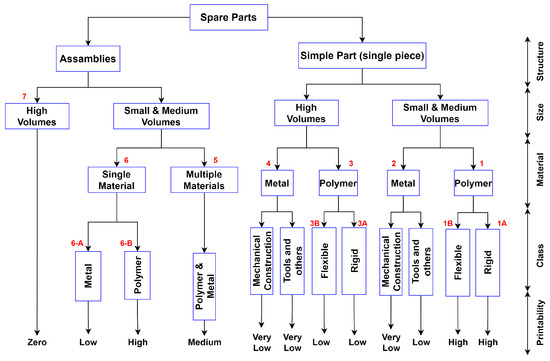
Figure 6.
Categorisation of the spare parts in the inventory.
3.2.2. The Selected Spare Parts
After classifying the pieces, two of them were selected to be printed from the partner Solitium in “HP 3D printers” and another one was printed from the AM company “Lupeon”. According to maximum printability criteria and taking into account the knowledge of the maintenance engineers and the functionality of the parts, two parts were selected to be made in PA12 by the HP Multi Jet Fusion 3D technology and one part to be made in PA12 using SLS technology. These parts belong to the first list because they contain the defined criteria that the company was looking for and they are all made of polymer.
- Spare part number 1 has the functionality of clamping a tool in order to lock its movements so that the tool is positioned in a certain way. It is a polymer part which is made of polyamide;
- The spare part number 2 is a cover (crankcase) for a tool. This part has three holes where the screw is put in order to assemble the spare part into the tool, to protect the mechanism of the tool;
- The spare part number 3 is made of PA12 using the SLS method in the EOSP396 PBF machine in Lupeon Company located in the Polígono do Molle, Nigrán, Pontevedra (Spain). The original spare part was made in polytetrafluoroethylene (PTFE).
Pieces number 1 and 2 were printed by the partner Solitium and they used the PA12 powder. The technology used is called HP Multi Jet Fusion. The Multi Jet Fusion 3D printing technology was developed to provide new levels of part quality in a fast and inexpensive way compared to existing 3D printing technologies [35].
Thirty parts per category were analysed from the total number of spare parts in the company’s warehouse. Based on the classification according to the above criteria, three polymer parts were selected, which were made at the partner additive manufacturing companies Lupeon and Solitium, as shown in Figure 7.
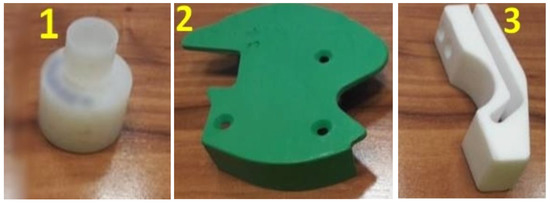
Figure 7.
Set of 3D spare parts selected; (1) Blocker (2) Crankcase (3) Spot welding spacing tools.
Table 1 and Table 2 show, respectively, the characteristics of the printer and the materials used for printing the parts. Similarly, Figure 8, Figure 9 and Figure 10 show the parts made by additive manufacturing with the previously mentioned material PA12. The configuration of multiple manufactured layouts is also shown in the spare part cases 1 and 2. Table 3 presents the summary and technical characteristics of parts 1–3 made by additive manufacturing, as well as the regular spare parts. Only the characteristics made available by the company were included.

Table 1.
Main characteristics of the HP Solitium Printer used for the parts 1 and 2.

Table 2.
Characteristics of the material PA12.
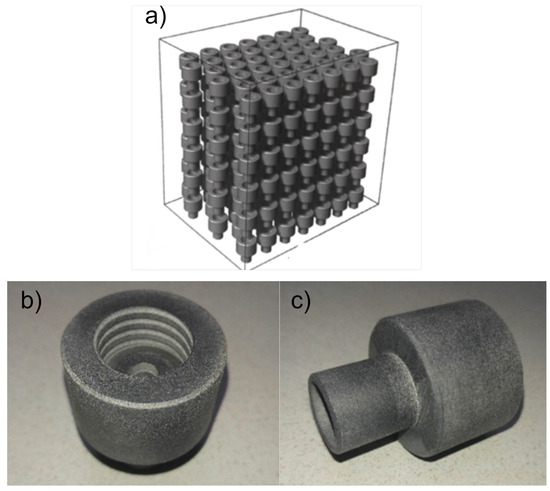
Figure 8.
Spare Part 1 selected, (a) Lay- out of 252 units, (b) Top side and (c) Bottom side.
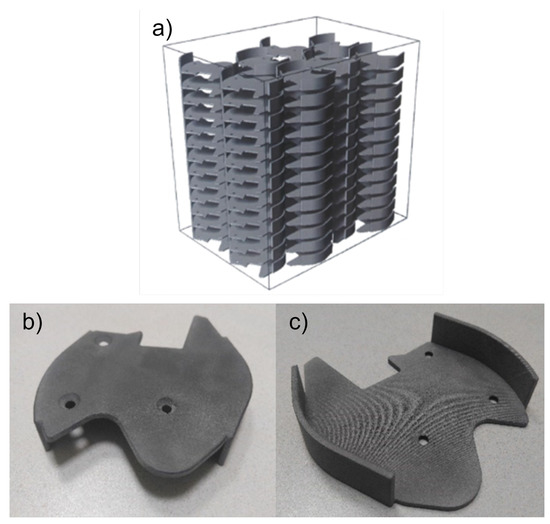
Figure 9.
Spare Part 2 selected, (a) Lay-out of 104 units, (b) Top side and (c) Bottom side.

Figure 10.
Spare Part 3 selected (a) Top side and (b) Bottom side.

Table 3.
Summary of spare parts printed.
3.3. Characterisation of the Spare Parts
Two non-destructive tests were carried out on the manufactured parts:
- Hardness measurement: the hardness test performed on the materials is the shore D hardness method, given that all the parts (both printed and the regular parts) were rigid polymers. According to the norms UNE-EN ISO 868 and 7619, the applied load is N. Two results were noted for each regular spare part:
- -
- The maximum value of the shore D hardness displayed for one piece;
- -
- The stabilised shore D hardness value during 10 s for one piece, which is marked as D/10 in the tables of hardness results.
- Roughness measurement: the objective of this test is to determine if the surface of the printed parts is close to the original parts, by evaluating and comparing their roughness parameters values to ensure their work in real situation otherwise operational. The spare parts have been measured in four different areas with a Taylor Hobson profilometer, according to ISO-4287, as shown in Table 4 [36]. The same direction and side have always been chosen to measure the profile of surface, and the cutoff equal to mm was selected. The radius of the stylus is 5 um. A measure length equal to 2 mm (five cutoff) and a Gaussian filter were used. The parameters used to define the roughness and waviness of the spare parts were Ra, Rq and Rt. In this research, the 2D parameters were used given their wide use in the industry. These measurements were obtained using the profile method, in order to know the initial parameters and their variability on the surface. Equation (2) shows the arithmetic mean profile (Ra) of the heights, along axis Z measured in a length L in axis X. Equation (3) presents the value of the heights square mean of the profile and Equation (4) denotes the maximum height (Rt) that is the sum of peak height (Rp) and valley depth (Rp).
 Table 4. Parameters profile surface according to ISO 4287.
Table 4. Parameters profile surface according to ISO 4287.
Table 5 shows the results of measurements on original spare parts and AM printed parts. The hardness was improved compared to the original parts. A slightly higher hardness can also be observed in the manufacturing process that uses the MultiJet 3D technology, compared to the SLS technology, as is shown in Figure 11.

Table 5.
Results of shore D hardness.
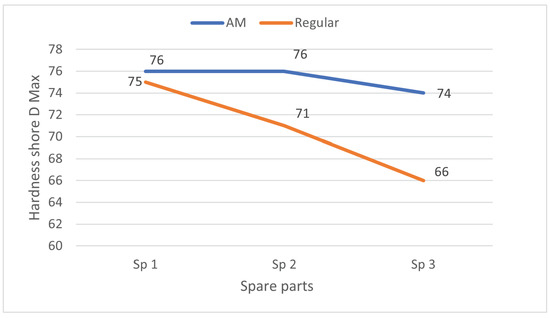
Figure 11.
Spare parts versus Hardness Shore D max.
The results obtained from measuring the roughness of the spare parts with the methodological conditions described above are shown in Table 6. The values obtained for Ra, Rq and Rt are shown graphically in Figure 12. The roughness of replacement parts can vary according to their functionality. As a rule, high Ra values were used when adhesion is a criterion for the usability of the replacement part and lower values were used to avoid wear. The parameter Rt indicates the maximum value between peak and valley and is complemented by Ra to the extent that it provides us with a clearer idea of the dispersion of the profile, although Rt is usually proportional to Ra, i.e., the higher the Ra the higher the Rt. According to the graph in Figure 12, the Ra increases in regular spare parts. In the case of the regular Sp3, the roughness increases, perhaps due to the type of material of the regular part, which is TPFE (Teflon). However, the parts made in AM have an apparently stable roughness. It seems that the surface quality of the part made using SLS is slightly better than the surface quality of those parts made through the multi-injection process.

Table 6.
Results of roughness measurements in spare parts.
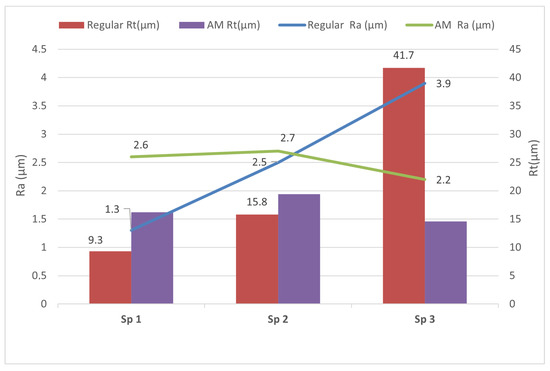
Figure 12.
Roughness measurements. Spare parts versus Ra and Rt.
4. Discussion
The selection of parts was not efficient or productive, requiring a lot of time to select the parts. The lists obtained are a small sample with an average of 15–20 parts per list compared to the total number of parts in the inventory. The part classifications found in the database are not adequate, as the choice of candidate parts for AM requires technical criteria. Moreover, the criteria chosen in the above listings are economic criteria, for which price and consumption have been considered as being more important than any other parameter. In the database, the parts have been ordered according to two variables: decreasing consumption (from the most consumable part to the non-consumable part) and decreasing price (from the most expensive part to the cheapest part). Thus, the verification of each part was necessary to study its possibility of being 3D printed, which complicated the selection. There is a need to improve the databases so that they can be linked with technical information data that can help to study 3D printability. It is worth mentioning that the material, dimensions and documentation of the numerical definition (NDF), i.e., 3D files and drawings, are not available for some parts.
An update of existing databases and the addition of missing data should be undertaken for efficient use of the inventory in the future. The printed spare parts should be tested in the company to study an example of use in preventive maintenance and they should be put in the same conditions as the regular ones to compare their operating parameters. In order to solve these problems, one suggestion would be to implement a control model for the spare parts inventory. Rodrigues et al. [37] have proposed models that use predictions of the Remaining Useful Life (RUL) of the monitored components, obtained through a Health Monitoring and Prognosis (PHM) system. This is intended to predict future demands for spare parts used in preventive maintenance [38].
5. Conclusions
In view of the above research work, the following conclusions can be drawn:
- Additive manufacturing of on-demand polymeric spare parts plays an important role in preventive maintenance and will become more important in the future;
- It is important to consider the AM manufacturing time for preventive maintenance, as this AM technology should be a useful tool;
- Around 80% of the properties of polymer spare parts are retained in the printed parts, which means that the functionality of the original spare parts is maintained;
- The production of polymeric spare parts with AM printing technologies is more economical with the multi-jet system than with the SLS system;
- HP MultiJet technology is a potential technology for the mass production of high turnover spare parts;
- In polymer AM, the costs and manufacturing time have dropped dramatically compared to those provided by conventional manufacturing;
- Metal AM technology for spare parts is costly and not yet economically profitable as it does not achieve the required production rates and accuracies.
Author Contributions
Conceptualization, A.P., M.D.-C., J.A. and R.L.; methodology, A.P., M.D.-C., J.A. and R.L.; validation, A.P. and A.C.; formal analysis, A.P. and A.C.; investigation, A.P., J.A. and R.L.; resources, A.P., J.A. and R.L.; data curation, A.P., M.D.-C., J.A. and R.L.; writing—original draft preparation, A.P., J.A. and R.L.; writing—review and editing, A.P., J.A. and R.L.; visualization, A.P., M.D.-C., J.A. and R.L.; supervision, A.P., M.D.-C. and J.A.; project administration, A.P., J.A. and M.D.-C. All authors have read and agreed to the published version of the manuscript.
Funding
This research was partially funded by the European Project “South Mediterranean Tunisian Maintenance Centre of Excellence” grant number 618718-EPP-1-2020-TN-EPPKA2-CBHE-JP and the European Project “Algerian National Laboratory for Maintenance Education” Project No. 586035-EPP-1-2017-1-DZ-EPPKA2-CBHE-JP.
Institutional Review Board Statement
Not applicable.
Informed Consent Statement
Not applicable.
Data Availability Statement
Data are contained withing the article.
Acknowledgments
The authors would like to thank Tahar Rili and the company Stellantys, particularly the head of the internal Maintenance Department of the Vigo Factory, Manuel Suárez.
Conflicts of Interest
The authors declare no conflict of interest.
Abbreviations
The following abbreviations are used in this manuscript:
| AM | Additive Manufacturing |
| DSS | Decision Support System |
| ML | Machine Learning |
| CM | Conventional Manufacturing |
| PM | Preventive Maintenance |
| MPPWT | Mean of Printed Part Working Time |
| PBF | Powder Bed Fusion Technology |
| PA12 | Polyamide 12 |
| PTFE | Polytetrafluoroethylene |
References
- Gibson, I.; Rosen, D.; Stucker, B. Additive Manufacturing Technologies: 3D Printing, Rapid Prototyping, and Direct Digital Manufacturing; Springer: New York, NY, USA, 2015; ISBN 978-1-4939-2113-3. [Google Scholar]
- Thomas, D.S.; Gilbert, S.W. Costs and Cost Effectiveness of Additive Manufacturing. In NIST Special Publication 1176; National Institute of Standards and Technology, US Department of Commerce: Gaithersburg, MD, USA, 2014. [Google Scholar]
- Muir, M.; Haddud, A. Additive manufacturing in the mechanical engineering and medical industries spare parts supply chain. J. Manuf. Technol. Manag. 2018, 29, 372–397. [Google Scholar] [CrossRef]
- Gebhardt, A.; Hötter, J.-S. Additive manufacturing by selective laser melting the realizer desktop machine and its application for the dental industry. Phys. Procedia 2010, 5, 543–549. [Google Scholar] [CrossRef]
- ISO/ASTM International ISO/ASTM 52900:2021(E); Additive Manufacturing-General Principles-Fundamentals and Vocabulary. ASTM International: West Conshohocken, PA, USA, 2021. Available online: https://www.iso.org/standard/74514.html (accessed on 10 October 2022).
- ISO 17296-2:2015; Additive Manufacturing-General Principles-Overview of Process Categories and Feedstock. Organization for Standardization: Geneva, Switzerland, 2015; Revised in 2020. Available online: https://www.iso.org/standard/61626.html (accessed on 10 October 2022).
- Khajavi, S.H.; Partanen, J.; Holmström, J. Additive manufacturing in the spare parts supply chain. Comput. Ind. 2014, 65, 50–63. [Google Scholar] [CrossRef]
- Sirichakwal, I.; Conner, B. Implications of Additive Manufacturing for Spare Parts Inventory. 3D Print Addit. Manuf. 2016, 3, 56–63. [Google Scholar] [CrossRef]
- Kostidi, E.; Nikitakos, N.; Progoulakis, I. Additive Manufacturing and Maritime Spare Parts: Benefits and Obstacles for the End-Users. J. Mar. Sci. Eng. 2021, 9, 895. [Google Scholar] [CrossRef]
- Westerweel, B.; Basten, R.; Boer, J.; Houtum, G. Printing Spare Parts at Remote Locations: Fulfilling the Promise of Additive Manufacturing. Prod. Oper. Manag. 2021, 30, 1615–1632. [Google Scholar] [CrossRef]
- Sartal, A.; Carou, D.; Davim, J.P. Enabling Technologies for the Successful Deployment of Industry 4.0; CRC Press: Boca Raton, FL, USA, 2020. [Google Scholar]
- Chen, J.; Gusikhin, O.; Finkenstaedt, W.; Liu, Y.-N. Maintenance, Repair, and Operations Parts Inventory Management in the Era of Industry 4.0. IFAC PapersOnLine 2019, 52, 171–176. [Google Scholar] [CrossRef]
- Ceruti, A.; Marzocca, P.; Liverani, A.; Bil, C. Maintenance in aeronautics in an Industry 4.0 context: The role of Augmented Reality and Additive Manufacturing. J. Comput. Des. Eng. 2019, 6, 516–526. [Google Scholar] [CrossRef]
- de Brito, F.M.; da Cruz, E.G.; Frazzon, M.; Basto, J.P.T.V.; Alcala, S.G.S. Design Approach for Additive Manufacturing in Spare Part Supply Chains. IEEE Trans. Ind. Inform. 2021, 17, 757–765. [Google Scholar] [CrossRef]
- Kretzschmar, N.; Chekurov, S.; Salmi, M.; Tuomi, J. Evaluating the Readiness Level of Additively Manufactured Digital Spare Parts: An Industrial Perspective. Appl. Sci. 2018, 8, 1837. [Google Scholar] [CrossRef]
- Bridges, S.M.; Keiser, K.; Sissom, N.; Graves, S.J. Cyber Security for Additive Manufacturing. In Proceedings of the 10th Annual Cyber and Information Security Research Conference (CISR’15), Oak Ridge, TN, USA, 7–9 April 2015; Association for Computing Machinery: New York, NY, USA, 2015; pp. 1–3. [Google Scholar] [CrossRef]
- Zhang, Y.; Jedeck, S.; Yang, L.; Bai, L. Modelling and analysis of the on-demand spare parts supply using additive manufacturing. Rapid Prototyp. J. 2019, 25, 473–487. [Google Scholar] [CrossRef]
- Montero, J.; Paetzold, K.; Bleckmann, M.; Holtmannspoetter, J. Re-design and re-manufacturing of discontinued spare parts implementing additive manufacturing in the military field. In Proceedings of the DESIGN 2018 15th International Design Conference, Dubrovnik, Croatia, 21–24 May 2018. [Google Scholar] [CrossRef]
- Coro, A.; Macareno, L.M.; Aguirrebeitia, J.; de Lacalle, L.N.L. A Methodology to Evaluate the Reliability Impact of the Replacement of Welded Components by Additive Manufacturing Spare Parts. Metals 2019, 9, 932. [Google Scholar] [CrossRef]
- Beiderbeck, D.; Deradjat, D.; Minshall, T. The Impact of Additive Manufacturing Technologies on Industrial Spare Parts Strategies; Centre for Technology Management Working Paper Series; Centre for Technology Management: Location, UK, 2018; ISSN 2058-8887. No. 1. [Google Scholar] [CrossRef]
- Yang, S.; Page, T.; Zhang, Y.; Zhao, Y.F. Towards an automated decision support system for the identification of additive manufacturing part candidates. J. Intell. Manuf. 2020, 31, 1917–1933. [Google Scholar] [CrossRef]
- Ghuge, S.; Dohale, V.; Akarte, M. Spare part segmentation for additive manufacturing—A framework. Comput. Ind. Eng. 2022, 169, 108277. [Google Scholar] [CrossRef]
- Chekurov, S.; Salmi, M.; Verboeket, V.; Puttonen, T.; Riipinen, T.; Vaajoki, A. Assessing industrial barriers of additively manufactured digital spare part implementation in the machine-building industry: A cross-organizational focus group interview study. J. Manuf. Technol. Manag. 2021, 32, 909–931. [Google Scholar] [CrossRef]
- Montero, J.; Weber, S.; Bleckmann, M.; Paetzold, K. A methodology for the decentralised design and production of additive manufactured spare parts. Prod. Manuf. Res. 2020, 8, 313–334. [Google Scholar] [CrossRef]
- Cantini, A.; Peron, M.; de Carlo, F.; Sgarbossa, F. A decision support system for configuring spare parts supply chains considering different manufacturing technologies. Int. J. Prod. Res. 2022, 1–21. [Google Scholar] [CrossRef]
- Sgarbossa, F.; Peron, M.; Lolli, F.; Balugani, E. Conventional or additive manufacturing for spare parts management: An extensive comparison for Poisson demand. Int. J. Prod. Econ. 2021, 233, 107993. [Google Scholar] [CrossRef]
- Knofius, N.; van der Heijden, M.C.; Sleptchenko, A.; Zijm, W.H.M. Improving effectiveness of spare parts supply by additive manufacturing as dual sourcing option. OR Spectr. 2021, 43, 189–221. [Google Scholar] [CrossRef]
- Barbosa, W.S.; Wanderley, R.F.F.; Gioia, M.M.; Gouvea, F.C.; Gonçalves, F.M. Additive or subtractive manufacturing: Analysis and comparison of automotive spare parts. J. Remanufacturing 2021, 12, 153–166. [Google Scholar] [CrossRef]
- Pérez, M.; Medina-Sánchez, G.; García-Collado, A.; Gupta, M.; Carou, D. Surface Quality Enhancement of Fused Deposition Modeling (FDM) Printed Samples Based on the Selection of Critical Printing Parameters. Materials 2018, 11, 1382. [Google Scholar] [CrossRef] [PubMed]
- Carello, M.; Amirth, N.; Airale, A.G.; Monti, M.; Romeo, A. Building Block Approach’ for Structural Analysis of Thermoplastic Composite Components for Automotive Applications. Appl. Compos. Mater. 2017, 24, 1309–1320. [Google Scholar] [CrossRef]
- Isasi-Sanchez, L.; Morcillo-Bellido, J.; Ortiz-Gonzalez, J.I.; Duran-Heras, A. Synergic Sustainability Implications of Additive Manufacturing in Automotive Spare Parts: A Case Analysis. Sustainability 2020, 12, 8461. [Google Scholar] [CrossRef]
- Westerweel, B.; Basten, R.J.I.; van Houtum, G.-J. Preventive Maintenance with a 3D Printing Option. SSRN Electron. J. 2019. [Google Scholar] [CrossRef]
- Khalil, Y.; Hopkinson, N.; Kowalski, A.; Fairclough, J.P.A. Characterisation of UHMWPE Polymer Powder for Laser Sintering. Materials 2019, 12, 3496. [Google Scholar] [CrossRef]
- Wencke, Y.L.; Proes, F.; Imgrund, P.; Luinstra, G.A. HDPE@UHMWPE Powders for Power Bed Fusion Based Additive Manufacturing. Macromol. Mater. Eng. 2022, 307, 2100964. [Google Scholar] [CrossRef]
- Kim, H.; Zhao, Y.; Zhao, L. Process-level modelling and simulation for HP’s Multi Jet Fusion 3D printing technology. In Proceedings of the 1st International Workshop on Cyber-Physical Production Systems (CPPS), Vienna, Austria, 12 April 2016. [Google Scholar] [CrossRef]
- ISO 25178-2:2012; Geometrical Product Specifications (GPS)-Surface Texture: Areal-Part2: Terms, Definitions and Surface Texture Parameters. International Organization for Standarization: Geneva, Switzerland, 2012; Revised in 2021. Available online: https://www.iso.org/standard/42785.html (accessed on 10 October 2022).
- Rodrigues, L.R.; Yoneyama, T. A spare parts inventory control model based on Prognostics and Health monitoring data under a fill rate constraint. Comput. Ind. Eng. 2020, 148, 106724. [Google Scholar] [CrossRef]
- Kim, T.Y.; Dekker, R.; Heij, C. Spare part demand forecasting for consumer goods using installed base information. Comput. Ind. Eng. 2017, 103, 201–215. [Google Scholar] [CrossRef]
Publisher’s Note: MDPI stays neutral with regard to jurisdictional claims in published maps and institutional affiliations. |
© 2022 by the authors. Licensee MDPI, Basel, Switzerland. This article is an open access article distributed under the terms and conditions of the Creative Commons Attribution (CC BY) license (https://creativecommons.org/licenses/by/4.0/).